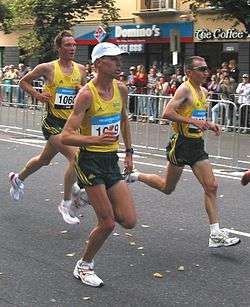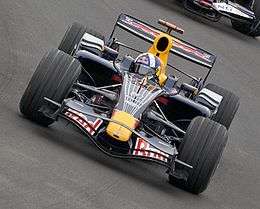Trail running
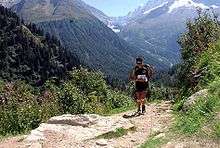
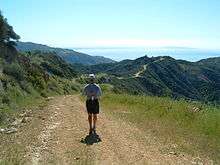
Trail running is a sport/activity which consists of running and hiking over trails. In the United Kingdom and Ireland it is also called mountain or fell running although the two types do differ. It differs from road running and track running in that it generally takes place on hiking trails, often in mountainous terrain, where there can be much larger ascents and descents. It is difficult to definitively distinguish trail running from cross country running. In general, however, cross country is an IAAF governed discipline that is typically raced over shorter distances.
The amount of organized trail races has grown over the past few years throughout the world, now well into the hundreds in North America alone.[1] Runners often cite less impact stress compared to road running, as well as the landscape and non-urban environment, as primary reasons for preferring trail running.[2] This move to nature is also reflected in a large increase in competitors in non-traditional/off-road triathlons and adventure racing over the past five years.[3]
Related activities
A growing number of people are participating in solo backcountry trail running trips, carrying an ultralight form of backpacking to allow faster speeds than with a traditional, heavier backpacking, These trips can be very difficult and dangerous, depending on length and mountain drop. Especially this has to be thoroughly evalueted before starting the trip because it can cause huge differences in duration of the trip itself. Usually it's accepted that 100mts in mountain drop can be considered like 1 km on a flat trail. Adherents find overcoming such challenges to be extremely rewarding because these adventures are absolutely not for everybody and can be dangerous if not well prepared and equipped.
Mountain running
Mountain or fell running, also known as hill running, is the sport of running and racing, off-road, over upland country where the gradient climbed is a significant component of the difficulty. The name arises from the origins of the English sport on the fells of northern Britain, especially those in the Lake District. Fell races are organized on the premise that contenders possess mountain navigation skills and carry adequate survival equipment as prescribed by the organizer. As opposed to trail running, fell races are often unmarked and on the open fell, competitors often are able to choose their own course to the top of a mountain or checkpoint.
Popularity and growth
According to a 2010 special report on trail running published by the Outdoor Industry Foundation, "4.8 million Americans ages 6 and older participated in trail running in 2009."[4] This research shows a particularly heavy following in the Mountain States, the Western US, and California.
Because of the natural or serene setting, trail running is viewed as a more spiritual activity than roadside running or jogging. Another reason for growth and popularity is the continual acknowledgment of environmentalism. There is a stress among many trail-race organizers to keep these races "green" or environmentally friendly and minimize disturbance within the natural environment.[5]
Equipment
Many trail runners use specially designed shoes that have aggressively knobby soles that are generally more rigid than road running shoes. The usually EVA compound midsole often contain a lightweight, flexible nylon plastic layer to protect the feet from puncture wounds from sharp rocks or other objects. Since trail running take place on softer surfaces (e.g., grass, dirt) than road races, cushioning is not as important so often the shoes are less 'cushioned' than their counterparts designed for tarmac. Additionally, trail running shoes are low to the ground which provides the best stability on uneven terrain. Recently, very thick sole running shoes are gaining popularity especially in Ultra-marathons. In events over 100 miles, they were the most common type of shoe used in 2013.
Other equipment includes wicking garments, water bottles, sunscreen, sunglasses, gaiters, insect repellant spray, headlamps and ivy block. Some trail runners attach lightweight crampons to the bottom of their shoes to aid with traction in the snow and on ice. An alternative way to carry water is use a hydration bladder with drinking tube carried in a backpack or waistpack.[6] Today, there are many racing vests that are lightweight alternative which allow runners the choice of reservoir based bladder or water bottles while allowing for carrying other items such as nutrition, hydration supplements and cold weather gear. Carrying the Ten Essentials may reduce the hazards inherent in wilderness travel. Some trail runners use ultra light hiking poles (which are often not allowed during competition) to increase speed and stability.
Races
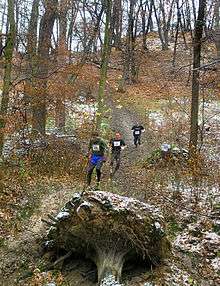
Trail running races are organised globally. Due to the relatively short history of trail running as an organised sport, there are very few established organising bodies. For example, in the United States, the American Trail Running Association was only founded in 1996 to represent trail races in the US.[7] In the United Kingdom, the Trail Running Association was formed in 1991. The International Trail Running Association (ITRA) was founded in 2013,[8] and was first recognised by the IAAF in 2015.
Distances in races vary widely, from 5 km, to over 100 miles (161 km). Many high-profile trail races are of ultramarathon distance. Races of similar distance often differ significantly in terms of terrain. This makes it difficult to compare performance across different courses. This is in contrast to times over standard distances in road running, such as 10 km or marathon.
Aid stations supplying food and beverages are commonly located every 5 to 10 kilometers along the course. Most trail races only have a single stage, where competitors are timed over the entire duration of their run, including stops at aid stations. However, trail running stage races also exist. These multiday stage races usually offer complete support and runner amenities between stages. There are, however, stage races that provide no support apart from water and medical aid, and require competitors to carry all their equipment (food, sleeping bag, change of clothes, compass). The best-known example of such races is the Marathon des Sables, that was first held in 1986.
Compared to road races, there are often fewer participants as number of entries is often limited. There can be a few reasons for this: narrowness of trails, national parks (where the courses are often set) limits, safety and environmental concerns. There are many popular races such as the Ultra-Trail du Mont-Blanc in Europe or the Western States Endurance Run in the United States that have been forced to limit entries due to overwhelming demand.
Some notable trail races include:
Africa
Asia
- Ultra-Trail Mount Fuji (UTMF): 161 km (since 2012)
- Trans Japan Alps Race (TJAR): 415 km (since 2002)
- Rinjani 100: 100 km (since 2016)
Europe
- Fruškogorski maraton: 125 kilometres (78 mi) (since 1978)
- Transvulcania: 83 kilometres (52 mi)
- Ultra-Trail du Mont-Blanc: 166 kilometres (103 mi)
- Tor des Géants: 330 kilometres (210 mi)
North America
- Badwater Ultramarathon: 135 miles (217 km)
- Bear 100 Mile Endurance Run: 100 miles (160 km)
- Dipsea Race: 7.5 miles (12.1 km) the oldest trail running event in the US
- Hardrock Hundred Mile Endurance Run: 100 miles (160 km)
- Leadville Trail 100: 100 miles (160 km)
- Western States Endurance Run: 100 miles (160 km)
- Barkley Marathons: 100 miles (160 km)
Oceania
- Five Peaks Ultramarathon: 58 kilometres (Adelaide, South Australia)
- Kepler Challenge: 60 kilometres (37 mi) also includes the Luxmore Grunt 28 kilometres (17 mi) (New Zealand)
- Kokoda Challenge Race: 96 kilometres (60 mi)
See also
References
- ↑ "Global Ultramarathon Races & Events Calendar". ULTRAmarathonRunning.com. Retrieved 25 March 2015.
- ↑ Jhung, Lisa. "Why Trail Running Is Good for You". runnersworld.com. Retrieved 27 June 2017.
- ↑ "Outdoor Participation Report 2013" (PDF). Outdoor Foundation. Archived from the original (PDF) on 24 September 2015. Retrieved 25 March 2015.
- ↑ "A Special Report on Trail Running". Outdoor Industry Foundation. 2010. Retrieved 2010-07-09.
- ↑ Farago, Susan. "From the Growth of Trail Running to Environmentalism". Austin Fit Magazine. Retrieved 3 December 2013.
- ↑ "What to look for in a running backpack". Cause I Love Running. Jessica Natalie. Retrieved 10 October 2016.
- ↑ "ATRA history". American Trail Ruunning Association. Retrieved 2012-08-25.
- ↑ "Presentation and objectives". International Trail Running Association. Retrieved 18 April 2016.
External links
| Wikimedia Commons has media related to Trail running. |
- Trail running at Curlie (based on DMOZ)
